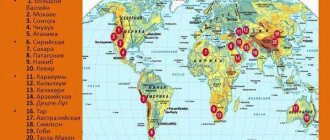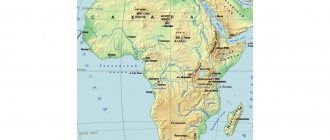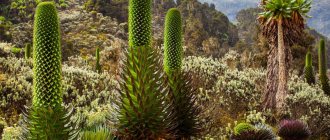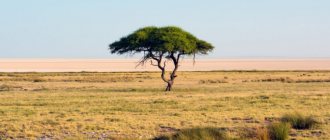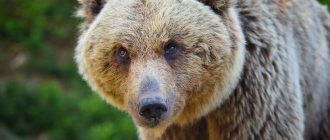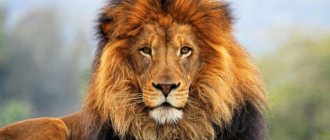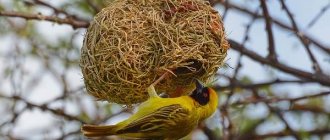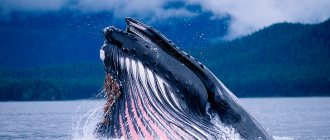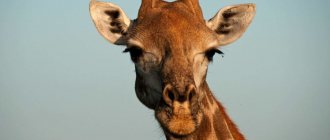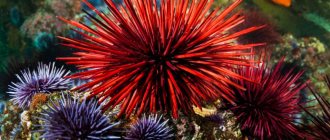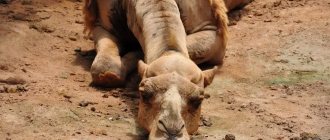One of the largest and most famous deserts on the planet is the Sahara, which covers the territory of ten African countries. In ancient writings the desert was called “great”. These are endless expanses of sand, clay, stone, where life is found only in rare oases. Only one river flows here, but there are small lakes in oases and large reserves of groundwater. The desert territory occupies more than 7,700 thousand square meters. km, which is slightly smaller in area than Brazil and larger than Australia.
The Sahara is not a single desert, but a combination of several deserts that are located in the same space and have similar climatic conditions. The following deserts can be distinguished:
Libyan
Arabian
Nubian
There are also smaller deserts, as well as mountains and an extinct volcano. You can also find several depressions in the Sahara, among which we can highlight Qatar, 150 meters deep below sea level.
Desert fauna: Dromedary camel
© Anna_Pakutina / Getty Images
It is worth noting that in the past, a large number of dromedary camels (or dromedaries) roamed the deserts of North Africa, but today only domesticated animals can be found, which, being incredibly strong and hardy animals, help people in African and Asian countries to transport heavy loads.
They are also used for riding. Contrary to the opinion of many people, these animals do not store water in their hump, but fat, which they feed on in case of food shortage.
Holy Scarab
A species of beetle from the lamellar family. The sacred scarab is considered the most powerful insect on Earth. These large black beetles reach 3-4 cm in length and weigh about 2 g. Scarabs are famous for their ability to move loads that are several times the weight of their own body. In ancient Egypt, the scarab was worshiped as a deity. The Egyptians saw his rolling of large dung balls as a symbol of the movement of the sun across the sky.
Animals living in the desert: Dorcas gazelle
© Fotomicar/Getty Images
This animal has a sandy color, which helps it camouflage in the desert. Thanks to the dew on the plants it feeds on, as well as the consumption of water-conserving plants, this gazelle can almost never drink.
The animal can reach a height of 65 cm and a weight of 25 kg. It is worth noting that the Dorcas gazelle instinctively jumps away when a predator approaches. This reflex serves as a warning signal to other gazelles. In addition, the Dorcas gazelle runs very quickly, reaching speeds of almost 80 km/h.
Horned viper
This poisonous snake, 60-80 cm long, inhabits the entire Sahara Desert, adjacent foothills and dry savannas. Its characteristic feature is 2 spiny scales above the eyes. During the day, the horned viper burrows into the sand or hides in rodent holes, and at nightfall it goes out to hunt for small rodents, lizards and birds. It is capable of completely burying itself in the sand in 10-20 seconds, leaving no traces on the surface.
What animals live in the desert: Addax (or mendes antelope)
© wrangel/Getty Images
Previously, addaxa could be seen in deserts and semi-deserts stretching from Western Sahara and Mauritania to Egypt and Sudan. Today, the range has decreased significantly - the Mendes antelope can be found only in a few sandy and rocky deserts of Niger, Chad, Mali, Mauritania, Libya and Sudan.
Thanks to the structure of their paws, these creatures can move through difficult, sandy areas without problems. But the same thing makes them vulnerable to danger - it is difficult for them to escape from predators. There are about 500 individuals in the world.
Relief
In fact, sand occupies only a quarter of the Sahara, and the rest of the territory is occupied by stone structures and mountains of volcanic origin. In general, we can distinguish the following objects in the desert:
- Western Sahara - plains, mountains and lowlands;
- Ahaggar - highland;
- Tibesti - plateau;
- Tenere – sandy expanses;
- Libyan Desert;
- Air - plateau;
- Talaq – desert;
- Ennedi – plateau;
- Algerian desert;
- Adrar-Iforas - plateau;
- Arabian Desert;
- El Hamra;
- Nubian Desert.
The largest accumulations of sand are in such sandy seas as Igidi and the Great Eastern Erg, Tenenre and Idehan-Marzuk, Shesh and Aubari, the Great Western Erg and Erg Chebbi. There are also dunes and dunes of various shapes. In some places there is the phenomenon of moving and also singing sands.
Desert terrain
If we talk in more detail about the relief, sands and the origin of the desert, scientists claim that the Sahara was previously an ocean floor. There is even a White Desert here, in which white rocks are the remains of various microorganisms of antiquity, and during excavations paleontologists find skeletons of various animals that lived millions of years ago. Now sands cover some parts of the desert, and their depth in some places reaches 200 meters. Sand is constantly transported by winds, forming new landforms. Under the dunes and sand dunes there are deposits of various rocks and minerals. When people discovered oil and natural gas deposits, they began to extract them here, although it is more difficult than in other places on the planet.
What animals live in the Sahara Desert: African ostrich
© vblinov/Getty Images
Although the ostrich cannot fly, it is one of the fastest animals on Earth, capable of reaching speeds of up to 70 km/h.
But besides its speed, the ostrich can boast of several more characteristics: it can move great distances, has excellent hearing and vision, and can safely fight off predators with its powerful legs.
Mainly feeds on grass, but sometimes eats small animals. Ostriches from the Sahara Desert are a separate subspecies.
Antelope oryx
This is a species of saber-horned antelope native to Africa. This animal is also called the oryx. The height of the oryx at the withers is about 120 cm, body weight is 200 kg. Both males and females have very long, thin, almost even horns, ranging from 100 to 150 cm in length. A characteristic feature of this antelope is the black and white coloring of the head. Oryx are very resilient and are able to run at high speed for tens of kilometers. In addition, they are quite brave animals and often go on the offensive when attacked by predators. A large male oryx can even kill a lion with its sharp horns.
Animals of deserts and semi-deserts: Jerboa
© Yerbolat Shadrakhov/Getty Images
This rodent lives in steppes, semi-deserts and deserts of the Palaearctic. It is able to withstand harsh climatic conditions.
In addition, this nocturnal animal is distinguished by its jumping ability - a quality that allows it to avoid predators.
Despite the fact that its body size can reach a length of only 25 cm, it is capable of reaching speeds of up to 25 km/h. Another interesting fact is that the jerboa does not drink water in the literal sense of the word; it obtains moisture from the food it eats. This rodent usually feeds on plants growing in the desert, seeds and insects.
fennec
Fennec foxes are mammals from the Canidae family that look like miniature foxes. They inhabit deserts, the largest population lives in the Sahara. These foxes are even smaller than adult domestic cats: their body length is 30-40 cm, their tail is up to 30 cm. The fennec weighs no more than 1.5 kg. Predators, nocturnal.
Interesting features of fennecs:
- The fennec cat has the largest ears in relation to the size of its head among predators. The length of the ears is up to 15 cm. Such ears help to regulate body temperature in the heat and to navigate well when hunting: to hear the slightest rustle of small vertebrates and insects.
- The feet are covered with thick down. Such “socks” help the fennec cat move along the hot desert sand.
- Young fennecs are almost white, and with age they become reddish or fawn, adapting to their habitat.
- Fenechs dig holes with a lot of secret passages.
- Fenechs are very social: they live in groups of several families and communicate with each other (bark, grumble, whine and howl).
- Fenechs are omnivores: they dig up eggs and underground parts of plants, eat fruits, carrion, insects and small vertebrates.
- Fenech jumps from a place to a height of 70 cm.
- Fenech is a symbol of Tunisia's ecology. In almost every city there are figures of this animal in a blue and white suit.
- The Firefox mobile browser logo features a fennec.
Fishes of Egypt
Egypt is washed by the Red Sea. Warm water throughout the year, an abundance of reefs and the beauty of the underwater world have formed an ideal place for diving. The Red Sea is home to 400 species of fish. Let's look at some of them.
Gray shark
This is a reef shark with gray sides and back, a whitish belly, it stays off the coast. The length of the fish is 1.5–2 m, weight - 35 kg. The common shark is distinguished from other gray sharks by the dark edging of all fins except the first dorsal.
Butterfly
The name summarizes about 60 species with many bright colors. They are characterized by a tall, laterally flattened body and an elongated tube-shaped mouth. All butterflies are small in size and live near reefs. Fish of this family are also kept in aquariums.
Puffer
This is one of the Red Sea pufferfish. Fish of this family have a large head, a wide and rounded back, an elongated tail, and miniature fins. They look unsightly. With their teeth fused into plates, these fish bite off corals. They swim alone.
Like most puffer fish, the puffer is poisonous - its toxin is more dangerous than cyanide. The poison is contained in the bone spines that cover the belly of the fish. At the moment of danger, the pufferfish swells, the spines pressed to the body begin to bristle.
Wart
The fish got its name because of growths on its body that resemble warts. The second name is stone fish, which is associated with its bottom lifestyle and camouflage among stones, where it lies in wait for prey. Like many bottom-dwelling predators, the wart's small eyes and mouth point upward. The spines of the stonefish's dorsal fins contain a toxin. It is not fatal, but causes pain and swelling.
Lionfish
One of the poisonous fish that lives in the waters of the Red Sea. Its name refers to the presence of massive fins divided into numerous feather-like appendages, which it flaps like wings. The second name is zebra fish, due to its striped contrasting color.
Lionfish fins contain poison. The beauty of the fish deceives inexperienced divers who try to touch the “zebra” and get burned.
Needle
There are more than 150 species of needles. A third of them live in the Red Sea. There are miniature ones, about 3 centimeters long, and 60 centimeters.
The needlefish is a relative of seahorses. The body of the fish is thin and elongated, surrounded by bony plates, together with a tube-shaped elongated mouth, giving the fish an external resemblance to a needle.
Napoleon
The name of the fish is associated with a prominent growth on its forehead, reminiscent of the cocked hat of the Emperor of France. Males and females of the species differ in color. In males it is bright blue, in females it is deep orange.
Don't forget about the freshwater fish of Egypt that live in the Nile. There you can find, for example, catfish, tiger fish, and Nile perch.
Experts believe that Egypt's fauna is so diverse due to the country's geographical location (it is located in the tropics). In addition, Egypt is a country of two continents, Eurasia and Africa.
The soil
Sahara soils are very poor in organic matter and have only slightly differentiated layers, which are often biologically inactive. Although nitrogen-fixing bacteria are still present in some areas. Soils located in lowlands and depressions are often saline, but on the outskirts of the desert there are soils containing more organic matter.
Atmospheric minerals are an important constituent of these soils, and reactive clays with expanding latticework are common. Free carbonates are often present, indicating minor leaching. Dense and hardened layers or crusts are mainly found in the northwestern part of the desert.
Characteristics of the main natural zones of Russia
It is best to enter basic data about the natural zones of Russia into a table, which can later be used to answer the teacher’s questions in class or to write a report on this topic or prepare a message.
The table can be compiled according to the following plan.
- Geographic location on the map.
- Climate characteristics.
- Temperature in winter and summer.
- Humidity.
- Soil characteristics.
- Characteristics of the plant world.
- Characteristics of the animal world.
- Human influence on natural areas.
Arctic desert zone
The Arctic desert zone of Russia is 85% covered with eternal ice. In summer the temperature does not rise above +5 degrees, but in winter the temperature can drop to -50. The soils here are very weak, infertile, and rocky. That is why the flora is very sparse. Prominent representatives of the flora are polar bears, reindeer, and polar owls. The ocean is rich in both fish and mammals: whales, seals, and seals.
Rice. 2. Types of the Arctic desert
Tundra zone
The entire zone can be divided into three large parts (moving south):
- Arctic tundra, with extremely sparse flora and fauna;
- lichen tundra - moss tundra, where a lot of moss and cloudberries grow;
- shrub tundra, with a large number of low-growing bushes and trees, herbs and berries.
The entire soil of the tundra is very poor in fertile layer, swampy with high acidity. The climate is harsh: long, cold, snowy winters, strong winds even in summer. That is why the forest cannot grow here.
The fauna of the zone is represented by such animals and birds as deer, white hares, geese, geese, waders, and white partridges.
Taiga
Taiga is the largest natural area in Russia. Interestingly, the characteristics of climate, soil, flora and fauna here may differ from each other in the east and west of the zone. This is due to the fact that it lies in two climatic zones: subarctic and temperate. On average, the climate here is quite mild, without sudden temperature changes. Humidity is high, there are many deep rivers, such as the Ob, Yenisei, Lena, as well as lakes and swamps. The dominant flora is coniferous trees, and the dominant animal species are brown bears, wolverines, lynxes, and deer. The soils are podzolic and swamp-podzolic, very fertile.
Forest zone
The zone of mixed and deciduous forests occupies almost the entire space of the East European Plain. The climate is mild, with high temperatures in summer and winter. The soils are fertile, rich in ash and humus.
The fauna is represented by a large number of different trees: spruce, pine, maple, birch, aspen, oak, elm. Among animals, the most prominent representative is the brown bear, among birds - woodpeckers and orioles.
Steppe
The climate of the steppes is characterized by sharp differences in heat and cold and low humidity. The soils are fertile chernozems. These are excellent conditions for growing various cereal crops. The animals are mostly small and nocturnal: marmots, gophers, jerboas. Among the birds, the largest is the steppe eagle.
Deserts
The climate in the Russian deserts is dry and hot. Soils are either sand, clay, or stones. Flora and fauna are scarce. Basically, these are small animals and perennial shrubs that bloom only in the spring, when there is excess moisture.
Transition zones
The table must also include transition zones, such as:
- forest-tundra;
- forest-steppe;
- semi-deserts.
Their characteristics are a combination of characteristics of the main zones close to them.
Rice. 3. What does the forest-tundra zone look like?
When characterizing all natural areas, it is necessary to remember that man has greatly influenced them: he built large cities, large industrial enterprises, and hydroelectric power stations. Agricultural activities have affected soil conditions, climate, flora and fauna.
Hyraxes
Hyrax is a species of Afro-Asian mammal. These are ungulates. Hyraxes' toes are protected by flat nails. The soles of their paws are long, like those of hamsters. They move easily along steep planes.
They cannot hide in holes or nests, since they are not adapted to dig them. Hyraxes use small caves and rock niches as shelter. Animals feed on grass, branches and leaves.
Scorpios
This is the oldest order among terrestrial arthropods. They are found only in hot countries. In the desert, scorpions hide among the stones. There they hide from the burning rays of the sun, waiting for darkness and coolness to come. As soon as dusk sets in, the scorpion, like a spider, quickly runs with its tail raised up, carefully feeling the road and all objects with its legs. Scorpions feed on insects and arachnids. They capture prey with their claws, lift it up above the cephalothorax and kill it with an injection of a poisonous sting, which is located at the end of the hind belly.
Scorpion poison
Scorpion sting
There are 2 types of scorpion venom. The first can kill or paralyze an invertebrate, but for humans it is no more dangerous than a wasp sting. The second can be fatal for people - it paralyzes the brain, nerves of the heart and pectoral muscles. In total, about 25 species of scorpions are known to be dangerous to humans. Their poison can cause uncoordination of movements, salivation, and vomiting. The affected area swells, turns red, itches, and hurts. There is a simple way to determine how poisonous a given scorpion is. If the claws look small compared to the huge stinger on the tail, then there is a lot of poison in this scorpion and it is better to stay away from it.
Mirages
In the Sahara, unique optical phenomena are observed in the atmosphere, thanks to which a person is able to see objects, for example, water sources, which in reality are very far away, tens or even hundreds of kilometers away. These phenomena are called mirages. They are explained by the total reflection of rays at the boundary of two layers of air having different temperatures and densities. There are even special maps of caravan routes in the Sahara with an assessment of the places where mirages usually occur.
Share link
Saharan cheetah
The cheetah belongs to the cat family, the genus cheetah. Unfortunately, there are currently no more than 250 individuals.
The Saharan cheetah has shorter fur and is not as brightly colored. Spots may be absent altogether. They hunt in the dark. Animals have adapted to hot climates and can live without water for a long time. They receive life-giving moisture from the blood of animals.
